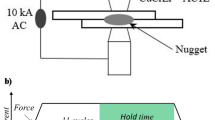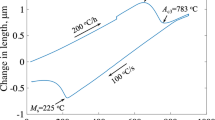Abstract
In recent years, application of high-strength steel in automobile bodies has been expanded to improve collision safety and fuel efficiency. However, it has been reported that for high-strength steels with strengths of at least 780 MPa, cross-tension strength (CTS) in resistance spot-weld joints decreases as steel strength increases. Methods of improving joint strength include post-heating. Although many studies have been conducted on post-heating, the temperature and microstructural changes required by post-heating to improve joint strength, such as a decrease in hardness and relaxation of solidification segregation elements, remain unclear. The effect of post-heating on CTS was investigated through resistance spot-weld joints of 1.5-GPa-class hot-stamped steel. We analyzed the temperature at the nugget edge during post-heating by using SORPAS, and conducted a reproducible thermal-cycle test simulating post-heating to determine the temperature range and microstructural changes necessary to improve joint strength. CTS was improved in two regions by varying the current ratio. In the tempering region, CTS varied in a wide range, and the current ratio varied in a narrow range. In the solidification segregation relaxation region, CTS did not vary, and the current ratio varied in a wide range. To improve CTS by tempering with post-heating, all solute carbon in martensite must be segregated or precipitated; the temperature for tempering with post-heating should be between 630 and 720 °C. To improve CTS by solidification segregation relaxation with post-heating, the P-enriched area fraction must be reduced; the temperature range for solidification segregation relaxation with post-heating should be between 860 and 1450 °C.











Similar content being viewed by others
References
Sato A (2005) The problem of the high strength steel and that countermeasure. Journal of the JSTP 46(534):548–551
Clare G (2008) Welding advanced high-strength steel is pushing welding technology. Penton's Weld Mag. 81(3):PP.14–16
Oikawa H, Murayama G, Sakiyama T, Takahashi Y, Ishikawa T (2007) Resistance spot weldability of high strength steel (HSS) sheets for automobile. Nippon Steel Tech Rep 95:39–45
Hirai T, Takahashi Y (1979) Resistance spot welding of high strength, IIW Doc. III-612–79
Beevers A, French EJ (1962) Post weld heat treatment of spot welds in hardenable steels. Brit Weld J pp 523–532
Defourny J, Bragard A (1984) Chemistry of high strength steel sheets for automotive industry and the criteria to define the resistance spot weldability. Revue de la Soudure 1(17):17–24
Saito T (1982) Welding technology 30:34–38
Hamatani H, Watanabe F, Miyazaki Y, Tanaka T, Maki J, Oikawa H, Nose T (2011) Characterization of cross tension strength in resistance spot welding ultrahigh strength steel sheets. Preprints of the National Meeting of JWS 89:44–45
Matsuyama K, Takahashi Y, Hasegawa K (2011) Fundamentals and practices of resistance welding, SANPO (Textbook)
Watanabe F, Furusako S, Hamatani H, Miyazaki Y, Nose T (2012) Fracture mechanical analysis of cross tension test for high-strength steel spot welded joints. Math Model Weld Phenom 10:653–667
Taniguchi K, Ikeda R, Endo S (2012) Development of resistance spot welding with pulsed current pattern for high strength steel sheets. Preprints of the National Meeting of JWS 90:240–241
Ito C, Hiratsuka K (1970) Determination of heat treatment conditions of spot welds in anti-corrosive high tensile steels. J Jpn Weld Soc 39:3
Wakabayashi C, Yasuyama M, Furusako S, Miyazaki Y (2015) Spot-welded joint-strength improvement by acceleration of auto-tempering at HAZ. Preprints of the National Meeting of JWS 96:38–39
Ramachandran DC, Figueredo B, Sherepenko O, Jin W, Park YD, Biro E (2022) A study on improving the mechanical performance by controlling the halo ring in the Q&P 980 steel resistance spot welds. J Manuf Process 75:320–330
Liu XD, Xu YB, Misra RD, Peng F, Wang Y, Du YB (2019) Mechanical properties in double pulse resistance spot welding of Q&P 980 steel. J Mater Process Tech 263:186–197
Eftekharimilani P, van der Aa EM, Hermans MJ, Richardson IM (2017) The microstructural evolution and elemental distribution of a 3rd generation 1 GPa advanced high strength steel during double pulse resistance spot welding. Weld World, pp.691–701
Sherepenko O, Juttner S (2019) Transient softening at the fusion boundary in resistance spot welded ultra-high strengths steel 22MnB5 and its impact on fracture processes. Weld World, pp.151–159
Taniguchi K, Matsuda H, Ikeda R (2016) Heat distribution in welds by short-time high-current post-heating and its improving effect on cross tension strength: development of resistance spot welding with pulsed current pattern for ultrahigh-strength steel sheets. Weld Int 30:817–825
Jahandideh A, Hamedi M (2011) An experimental study on effects of post-heating parameters on resustance spot welding of SAPH440 steel. Sci Technol Weld Joining 16:669–675
Yuanfang W, Kai D, Bingge Z, Yuanheng Z, Guanzhi W, Tao W, Hua P, Yulai G (2020) Highly enhanced cross tensile strength of the resistance spot welded medium manganese steel by optimized post-heating pulse, TMS 2020 149th Annual Meeting & Exhibition Supplemental Proceedings, pp.1871–1880
Wakabayashi C, Furusako S, Miyazaki Y (2015) Strengthening spot weld joint by autotempering acceleration at heat affected zone. Sci Technol Weld Joining 20:468–472
Wei S, Liu D, Lin L, Guo Y (2014) Similar and dissimilar resistance spot welding of advanced high strength steels: welding and heat treatment procedures, structure and mechanical properties. Sci Technol Weld Joining 19:427–435
Jahandideh A, Hamedi M, Mansourzadeh S, Eisazadeh H, Rahi A (2010) Investigating the effects of post heating parameter on the quality of automotive body joints in resistance spot welding,” 63rd Annual Assembly & International Conference of the International Institute of Welding, pp.733–737
Taniguchi K, Okita Y, Ikeda R (2015) Development of next generation development of next generation improving the weld properties of advanced high strength steel sheets. JFE Tech Rep 20:85–91
Hiroshi M, Koichi T, Rinsei I, Kenji O (2020) Microstructure and its hardness estimation of resistance spot weld of ultra-high strength steel sheets: development of resistance spot welding with pulsed current pattern for ultra-high strength steel sheets. Weld Int 34:166–175
Koichi T, Hiroshi M, Rinsei I (2019) Influence of the pulsed current pattern on cross-tension strength of spot-welded joint with nugget diameter variation. Development of resistance spot welding with a pulsed current pattern for ultra-high-strength steel sheets. Weld Int 33:211–222
Yuanfang W, Kai D, Bingge Z, Yuanheng Z, Guanzhi W, Tao W, Hua P, Yulai G. Effect of the cooling time on the cross tensile strength of the resistance spot welded medium manganese steel, TMS 2020 149th Annual Meeting & Exhibition Supplemental Proceedings, pp.515–523, 2020.
Maruyama N, Tabata S (2018) Atom prove analysis of carbon distribution in low and medium carbon as-quench martensite, CAMP-ISIJ Vol.31:943
Cracknell A, Petch N (1955) Frictional force on dislocation arrays at the lower yield point in iron. Acta Metall 3:186–189
Takaki S (2019) Work hardening in ferritic steel. Tetsu-to-Hagané 105:10
Paul SG (1976) Diffusion in solids, CORONA PUBLISHING CO., LTD
Furusako S, Miyazaki Y, Hamatani H, Akiniwa Y (2015) Consideration of decision guidelines for welding condition by analytic solution of heat conduction equation. Quarterly J Jpn Weld Soc 33(2):160–170
Oikawa H (1982) Lattice diffusion in iron. Tetsu Hagane 68:10
Author information
Authors and Affiliations
Corresponding author
Ethics declarations
Conflict of Interest
The authors declare no competing interests.
Additional information
Publisher's note
Springer Nature remains neutral with regard to jurisdictional claims in published maps and institutional affiliations.
Recommended for publication by Commission III - Resistance Welding, Solid State Welding, and Allied Joining Process
Rights and permissions
Springer Nature or its licensor (e.g. a society or other partner) holds exclusive rights to this article under a publishing agreement with the author(s) or other rightsholder(s); author self-archiving of the accepted manuscript version of this article is solely governed by the terms of such publishing agreement and applicable law.
About this article
Cite this article
Taniguchi, T., Furusako, S. & Kodama, S. Examination of post-heating conditions to improve CTS in resistance spot-weld joints. Weld World 67, 1359–1366 (2023). https://doi.org/10.1007/s40194-023-01477-8
Received:
Accepted:
Published:
Issue Date:
DOI: https://doi.org/10.1007/s40194-023-01477-8




